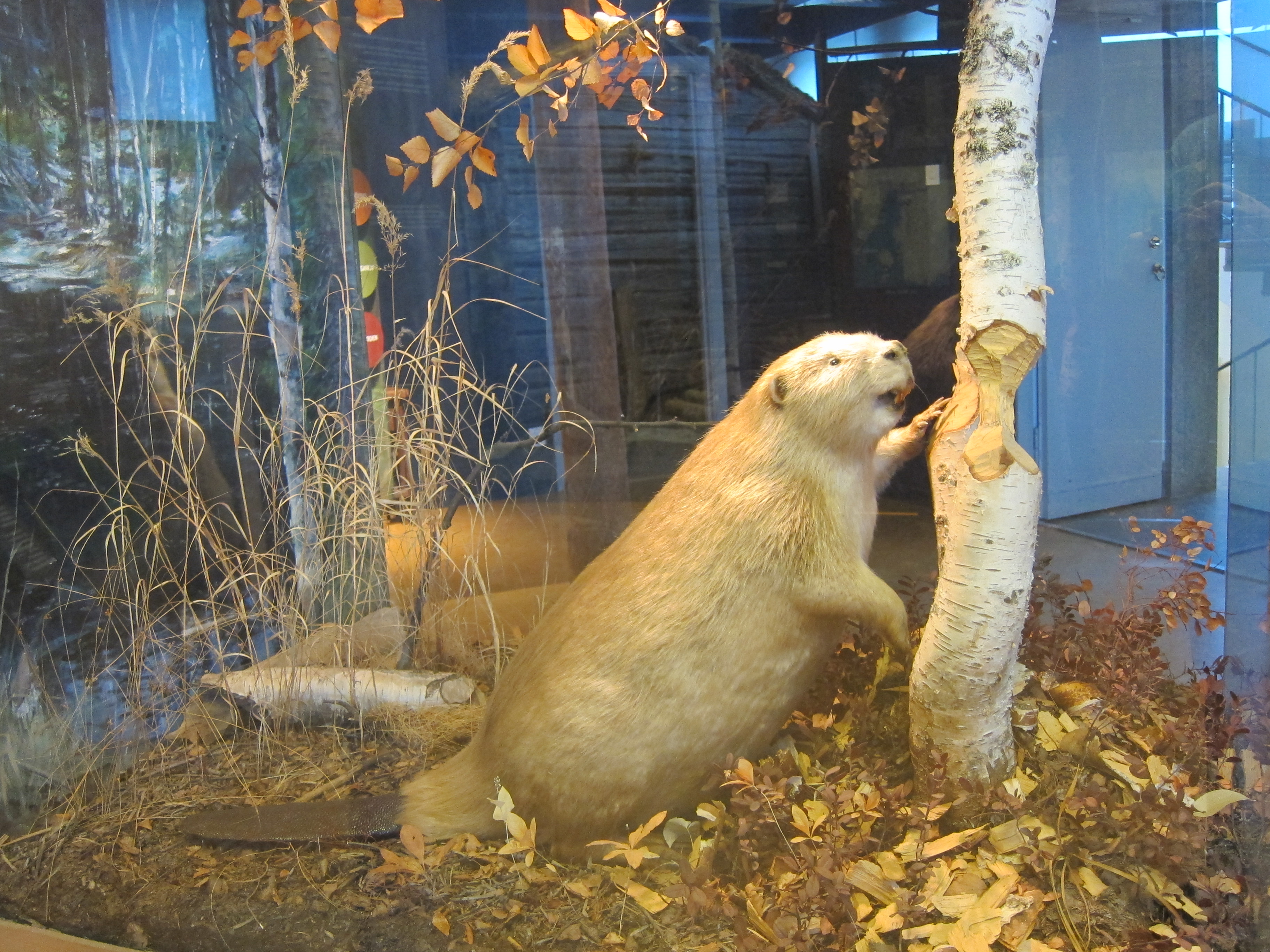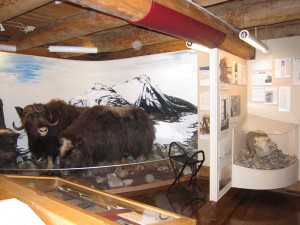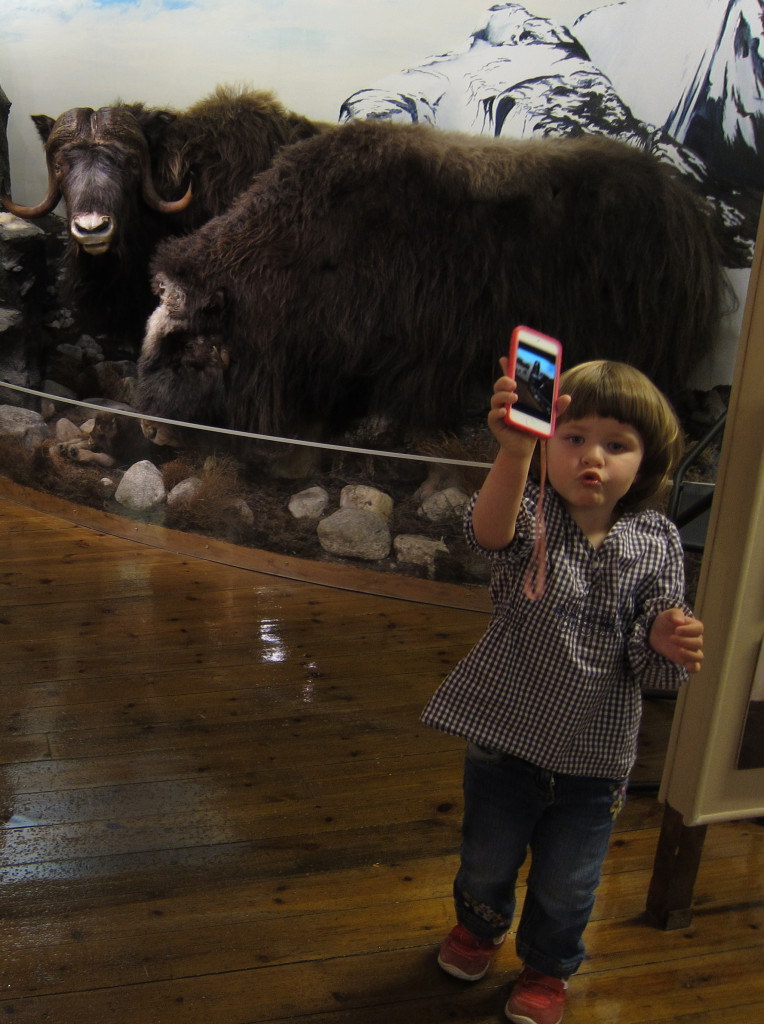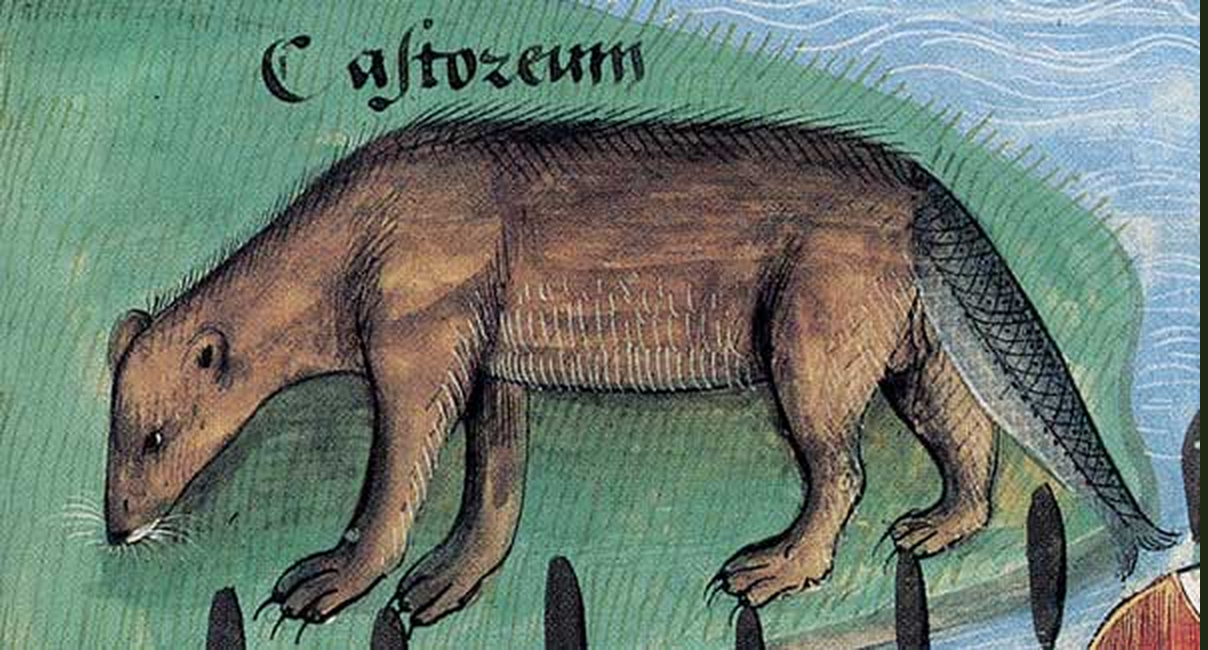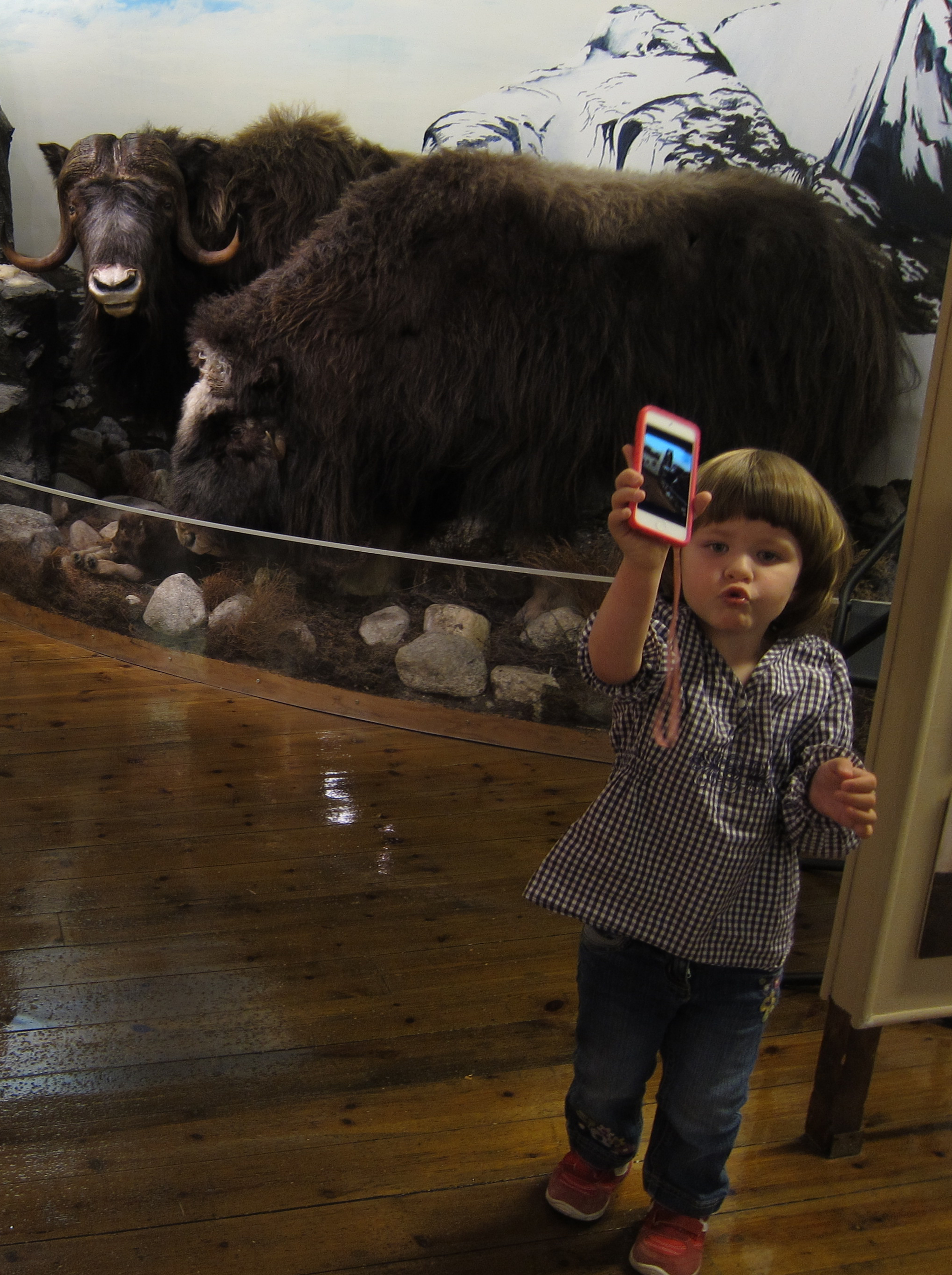
Museum menageries
A photo I took of a muskox on display at the Vitenskapsmuseet in Trondheim has just won 3rd place in the A Snapshot of the Field 2013 competition put on by the Network in Canadian History & Environment (NiCHE). In honor of that honor, I wanted to share some portraits of museum muskox I’ve taken as part of this project. Each specimen has its own story to tell–one in which reintroduction, public understanding of science, and individual animals’ histories converge.
1. Just touch me! Vitenskapsmuseet, Trondheim, Norway (The prize winner)
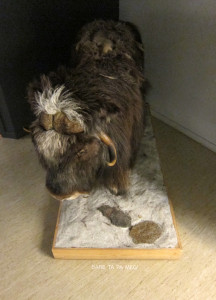 On 23 June 2013, I was coming toward the end of a week and a half archival work / field visit driving tour through Sweden and Norway for my Return of Native Nordic Fauna project. A decided to make a short stop at the Vitenskapsmuseet in Trondheim, Norway, to see if it happened to have any of the animals I am researching on display. Within a dusty exhibit titled ‘Natur-miljø’ (Nature environment) on a dimly lit balcony-style floor, I saw this secluded muskox standing in the corner. It is a descendent of muskox caught in Greenland and reintroduced to Norway in the 20th century. It seemed to cry out for attention to break its dreadful loneliness with the words poignantly written by curators on the ground: ‘Just touch me!’ (Bare ta på meg!) And indeed it appears to have been touched many times over the years, as almost all of its qiviut, the muskox’s softest and most valuable wool, was missing from the middle of its back. Like many other visitors to the museum, I touched the muskox, but in addition to hair, I could feel the cold plastic form over which the skin had been stretched to make the mounted specimen standing before me. In my tactile encounter in the corner, reaching out and touching the muskox exposed how unnatural nature often is.
On 23 June 2013, I was coming toward the end of a week and a half archival work / field visit driving tour through Sweden and Norway for my Return of Native Nordic Fauna project. A decided to make a short stop at the Vitenskapsmuseet in Trondheim, Norway, to see if it happened to have any of the animals I am researching on display. Within a dusty exhibit titled ‘Natur-miljø’ (Nature environment) on a dimly lit balcony-style floor, I saw this secluded muskox standing in the corner. It is a descendent of muskox caught in Greenland and reintroduced to Norway in the 20th century. It seemed to cry out for attention to break its dreadful loneliness with the words poignantly written by curators on the ground: ‘Just touch me!’ (Bare ta på meg!) And indeed it appears to have been touched many times over the years, as almost all of its qiviut, the muskox’s softest and most valuable wool, was missing from the middle of its back. Like many other visitors to the museum, I touched the muskox, but in addition to hair, I could feel the cold plastic form over which the skin had been stretched to make the mounted specimen standing before me. In my tactile encounter in the corner, reaching out and touching the muskox exposed how unnatural nature often is.
2. Kolthoff’s East Greenland Herd. Biologiska museet, Stockholm, Sweden
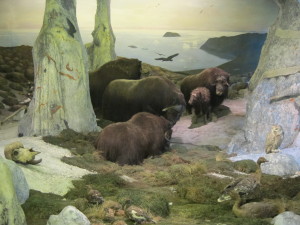 On the first floor of the Biologiska museet, which was founded in 1893 near the Skansen open air museum, I enountered a diorama of Greenland in July 2012. The diorama’s main creatures are a herd of muskox, although other polar birds and mammals like a polar fox are on display. Gustaf Kolthoff, who founded the museum, went on an expedition to East Greenland in 1900 to collect specimens. During that expedition, Kolthoff successfully captured two live calves, Hjalmar and Lotte, who were taken to Jamtland, Sweden, in hopes of starting a muskox domestication project. They both lived less than 4 years after their relocation. The specimens in Kolthoff’s diorama herd were some of the individuals killed during the attempts to catch the live calves, which is detailed in Kolthoff’s Till Spetsbergen och Nordöstra Grönland år 1900.
On the first floor of the Biologiska museet, which was founded in 1893 near the Skansen open air museum, I enountered a diorama of Greenland in July 2012. The diorama’s main creatures are a herd of muskox, although other polar birds and mammals like a polar fox are on display. Gustaf Kolthoff, who founded the museum, went on an expedition to East Greenland in 1900 to collect specimens. During that expedition, Kolthoff successfully captured two live calves, Hjalmar and Lotte, who were taken to Jamtland, Sweden, in hopes of starting a muskox domestication project. They both lived less than 4 years after their relocation. The specimens in Kolthoff’s diorama herd were some of the individuals killed during the attempts to catch the live calves, which is detailed in Kolthoff’s Till Spetsbergen och Nordöstra Grönland år 1900.
3. Food for the seal trappers. Polarmuseet, Tromsø, Norway
The Polarmuseet presents the history of exploitation and exploration of the polar areas by Norwegians. Taxidermied muskox appeared in several places in the museum when I visited in July 2013. In the section on the Norwegian hunting practices on East Greenland, a family group of muskox stand opposite of informational boards discussing the use of muskox meat to feed the hunters and their sled dogs. This exhibit, unlike any other I’ve seen, focuses on death. The muskox skull and pictures of hanging meat make it clear that the animals were killed — although the standing family with a cute baby seems to counter that ‘dark’ read of the scene.
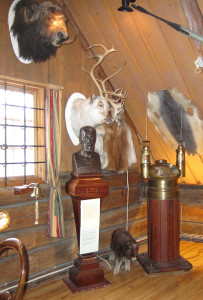 There is also mention of the relocation of muskox to Svalbard, but this is a pretty small part of the display and easy to miss. Although stuffed muskox appear above and next to the bust of Adolf Hoel, who reintroduced live muskox to both Svalbard and Dovre mountains, his part in this history does not appear on the text below his bust. The museum has many, many muskox displayed in corners and on walls, but these are presented with little explanation of their presence here, or absence from their homes.
There is also mention of the relocation of muskox to Svalbard, but this is a pretty small part of the display and easy to miss. Although stuffed muskox appear above and next to the bust of Adolf Hoel, who reintroduced live muskox to both Svalbard and Dovre mountains, his part in this history does not appear on the text below his bust. The museum has many, many muskox displayed in corners and on walls, but these are presented with little explanation of their presence here, or absence from their homes.
4. Misplaced muskox. Frösö zoo, Östersund, Sweden
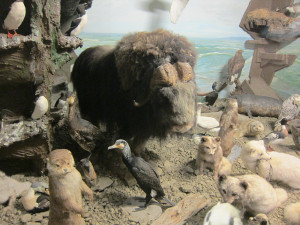 Frösö zoo, which I visited in June 2013, has a biological museum of dioramas entitled ‘From Skåne til Svalbard’, which the zoo claims shows animals “placed in their correct environments.” The Svalbard section is filled with birds and mammals, including a huge rearing polar bear and a muskox. What’s exceptional about this is that the exhibit was opened in 1986, but the last known sighting of muskox on Svalbard was in 1985. While muskox had been reintroduced to Svalbard in 1929, they were no longer inhabiting the island, making this muskox a misfit in the diorama.
Frösö zoo, which I visited in June 2013, has a biological museum of dioramas entitled ‘From Skåne til Svalbard’, which the zoo claims shows animals “placed in their correct environments.” The Svalbard section is filled with birds and mammals, including a huge rearing polar bear and a muskox. What’s exceptional about this is that the exhibit was opened in 1986, but the last known sighting of muskox on Svalbard was in 1985. While muskox had been reintroduced to Svalbard in 1929, they were no longer inhabiting the island, making this muskox a misfit in the diorama.
5. Kjell. Myskoxcentrum visitor center, Tännäs, Sweden
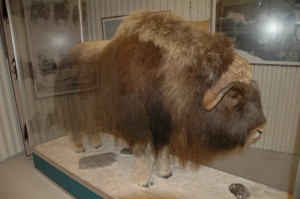 When you tour the Myskoxcentrum in Härjedalen, the first stop in the visitors center and museum where the history of the muskox both globally and Sweden is recounted for visitors. Kjell stands in a glass case, taking up a large portion of the floor space. Kjell (who of course was given this name by human bistanders) was a calf when his herd of 5 individuals migrated from Norway into Sweden in 1971. A photo of Kjell in the herd is on the wall facing his now stuffed body. In the winter of 1976, Kjell got his leg caught in some wire, seriously injuring it. The authorities decided to intervene with veterinarian assistance, but Kjell did not make it through the anesthesia. This is the only mounted muskox I’ve encountered who is given a personal story.
When you tour the Myskoxcentrum in Härjedalen, the first stop in the visitors center and museum where the history of the muskox both globally and Sweden is recounted for visitors. Kjell stands in a glass case, taking up a large portion of the floor space. Kjell (who of course was given this name by human bistanders) was a calf when his herd of 5 individuals migrated from Norway into Sweden in 1971. A photo of Kjell in the herd is on the wall facing his now stuffed body. In the winter of 1976, Kjell got his leg caught in some wire, seriously injuring it. The authorities decided to intervene with veterinarian assistance, but Kjell did not make it through the anesthesia. This is the only mounted muskox I’ve encountered who is given a personal story.
6. A family affair. Nasjonalparksenter Dovrefjell, Dombås, Norway
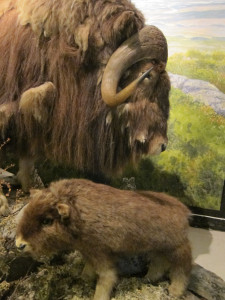 I stopped at the National park center in Dombås in June 2013 on my way to a muskox safari to see the live muskox in the Dovre mountains. The final room of the center features muskox, including a lovely family scene of a mother and calf, although in reality the adult is probably not the calf’s mother but that’s the way taxidermy works. It is really striking how many exhibits include calves, which certainly makes them elicit an ‘awww, how cute’ from visitors. The exhibit has adult skulls on the facing wall, but these are presented as ‘natural’ deaths, like seeing a skull in the desert. The text next to the calf as well as a larger stone and glass marker in the corner discuss when muskox were reintroduced to Dovre.
I stopped at the National park center in Dombås in June 2013 on my way to a muskox safari to see the live muskox in the Dovre mountains. The final room of the center features muskox, including a lovely family scene of a mother and calf, although in reality the adult is probably not the calf’s mother but that’s the way taxidermy works. It is really striking how many exhibits include calves, which certainly makes them elicit an ‘awww, how cute’ from visitors. The exhibit has adult skulls on the facing wall, but these are presented as ‘natural’ deaths, like seeing a skull in the desert. The text next to the calf as well as a larger stone and glass marker in the corner discuss when muskox were reintroduced to Dovre.
7. Death and disease. Vitenskapsmuseet, Trondheim, Norway
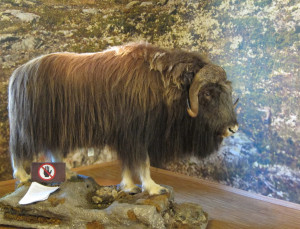 I’ll end this virtual museum tour by ending up where I started at the Vitenskapsmusset in Trondheim. The sad lonely muskox in the dark upstairs corner was not the only muskox on display there. A very well preserved muskox proudly greeted the visitor as the first thing in the exhibit hall. This muskox was presented with a large background picture of one of the mountains in the Dovre area. The large print standing sign used half of the space to present the muskox as a species and the other half to discuss the die-off of a large number of muskox in 2012 (according to the sign 70 by October, but the actual number was more like 100). The standing muskox certainly doesn’t look sick, so the message and the display don’t match at a fundamental level.
I’ll end this virtual museum tour by ending up where I started at the Vitenskapsmusset in Trondheim. The sad lonely muskox in the dark upstairs corner was not the only muskox on display there. A very well preserved muskox proudly greeted the visitor as the first thing in the exhibit hall. This muskox was presented with a large background picture of one of the mountains in the Dovre area. The large print standing sign used half of the space to present the muskox as a species and the other half to discuss the die-off of a large number of muskox in 2012 (according to the sign 70 by October, but the actual number was more like 100). The standing muskox certainly doesn’t look sick, so the message and the display don’t match at a fundamental level.
A final word
My 6-year-old daughter has recently become convinced that muskox are my favourite animal. She has seen that I have many pictures of them and when we were in Tromsø and visited the Polarmuseet as a family, she saw me get very excited to see the muskox displays. It’s not actually my favourite animal, but it certainly has a fascinating history. Of course, I was not the only one excited to see muskox. My favourite picture of a museum muskox is one that shows how these exhibits speak to people: in it, my 4-year-old daughter Lina is showing off the picture she took of the Polarmuseet muskox family and saying ‘moooo’. That’s what I’ll leave you with to ponder the way museum menageries make a difference.
